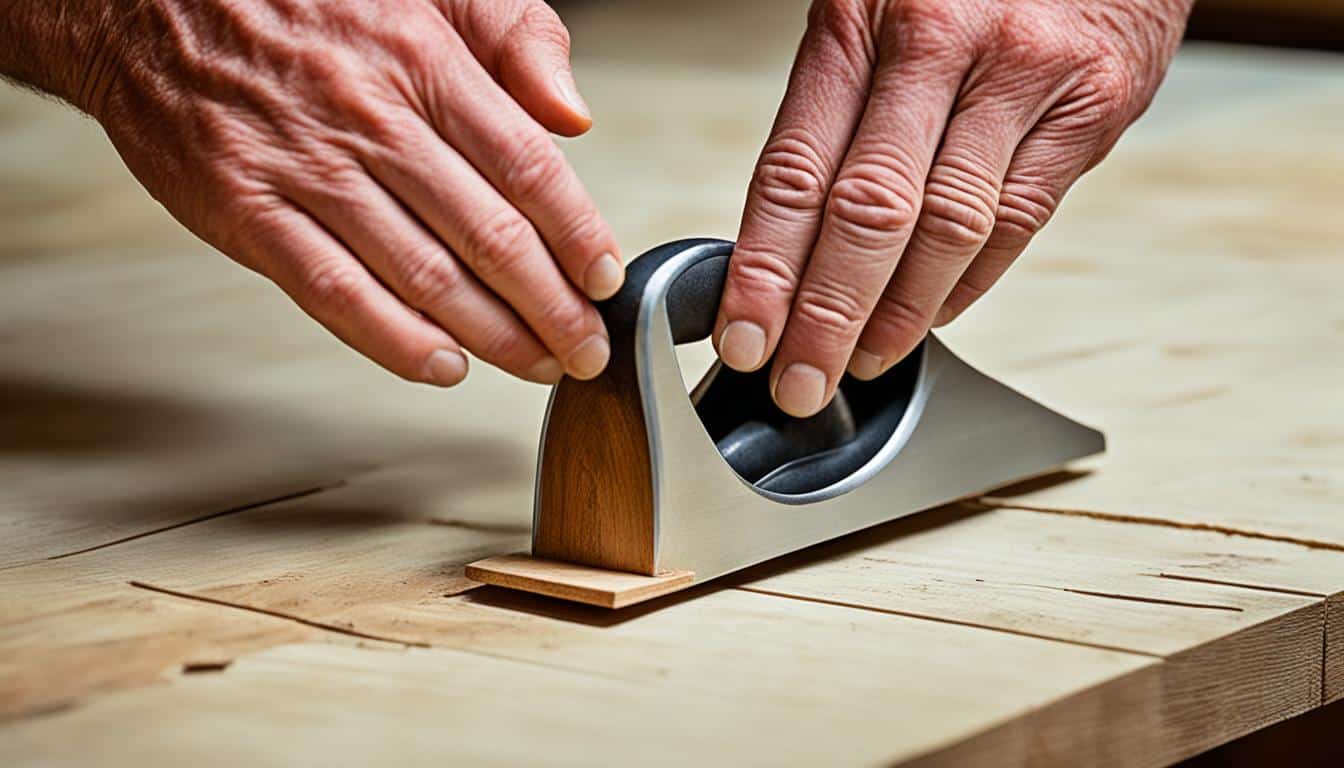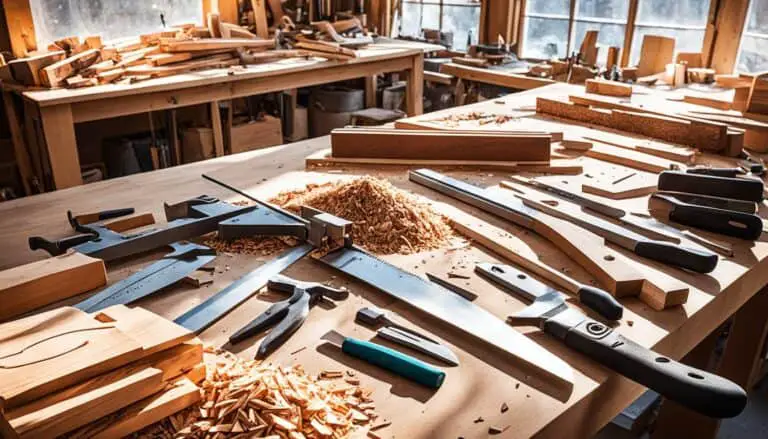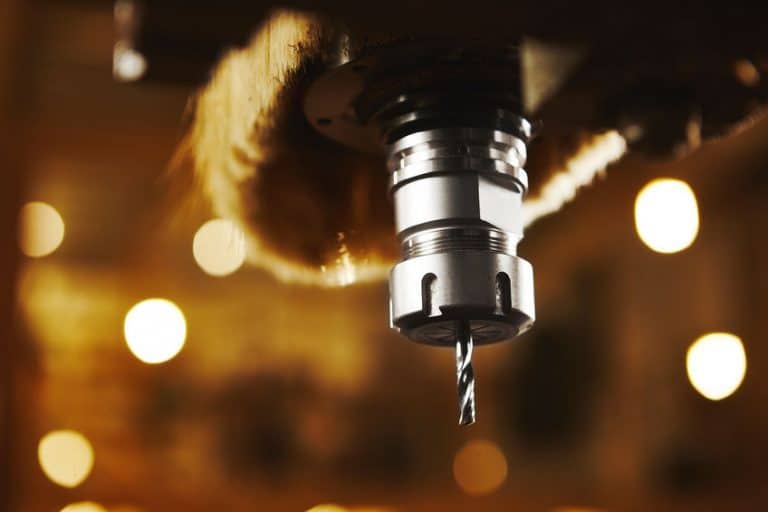Woodworking is a versatile craft that allows you to create beautiful and functional pieces from wood. Whether you’re a beginner or an experienced woodworker, having the right tools is essential to take your craft to new heights. But with so many woodworking tools available, how do you know which ones are truly essential?
In this guide, we’ll explore the must-have woodworking tools that every craftsman should have in their arsenal. From hand saws and power saws to planes, sanders, and more, these tools will help you achieve precise and professional results in your woodworking projects. So, let’s dive in and discover the tools that will make your woodworking journey a success!
Key Takeaways:
- Investing in the right woodworking tools is crucial for creating beautiful and functional pieces.
- Hand saws are essential for cutting and shaping wood, while power saws offer speed and efficiency.
- Planes and sanders help shape and smooth wood surfaces, while files provide precision and smoothness.
- A hammer, mallet, drill, screw gun, tape measure, and square are essential hand tools for various woodworking tasks.
- Having the right woodworking tools will enable you to achieve precise and professional results in your projects.
Hand Saws
Hand saws are an essential part of any woodworker’s toolkit. They are used for cutting materials and shaping wood. There are different types of hand saws available, each designed for specific cutting tasks.
- Crosscut saws: These saws are designed for cutting across the grain of the wood. They have a series of evenly spaced teeth that make clean, precise cuts.
- Rip saws: Rip saws are used for cutting along the grain of the wood. They have fewer teeth per inch compared to crosscut saws, allowing for efficient material removal.
- Coping saws: Coping saws are ideal for making intricate curved cuts. They have a thin and narrow blade, which allows for greater maneuverability.
Investing in a good set of hand saws will ensure that you have the right tool for any cutting task. Whether you need to make straight cuts, curved cuts, or rip through thick wood, there is a hand saw available to suit your needs.
“A well-crafted hand saw is a woodworker’s best friend. It allows for precise and accurate cuts, ensuring that your woodworking projects turn out beautifully.” – John Peterson, Master Woodworker
Choosing the Right Hand Saw
When selecting hand saws for your woodworking projects, consider the following factors:
- Blade Length: The blade length determines the depth of the cut. Choose a blade length that suits the thickness of the wood you typically work with.
- Teeth Per Inch (TPI): Different hand saws have varying TPI, which affects the type of cut it can make. Higher TPI is suitable for fine, smooth cuts, while lower TPI is better for rough cuts.
- Handle Comfort: Ensure that the handle feels comfortable and provides a secure grip. This is especially important for long cutting sessions, as it reduces hand fatigue.
- Blade Material: Look for saw blades made of high-quality steel or carbide for durability and sharpness.
By considering these factors, you can select the right hand saws that will meet your woodworking needs and provide you with precise and clean cuts.
Power Saws
Power saws are revolutionizing the world of woodworking, making it easier and more efficient to cut through wood. These electric saws are designed to save you time and effort, allowing you to focus on the artistry of your craft. When it comes to power saws, there are several types to choose from, each with its own unique benefits and applications.
Circular Saws
Circular saws are versatile and essential power tools for woodworking. They are designed for a wide range of cutting tasks and can easily handle different materials, including wood, plastic, and metal. With their rotating circular blade, circular saws make quick work of straight cuts, bevel cuts, and even plunge cuts. With the right blade, you can achieve precision and accuracy in your woodworking projects.
Jigsaws
If you’re looking to make intricate cuts and curves in your woodworking projects, a jigsaw is the power saw for you. Jigsaws feature a reciprocating blade that moves up and down, allowing you to make detailed and precise cuts. Whether you’re creating curved designs or making cutouts, a jigsaw provides the maneuverability and control you need to bring your vision to life.
Compound Miter Saws
Compound miter saws are designed to make precise miter and bevel cuts, making them an indispensable tool for woodworking. With their rotating blade and adjustable cutting angles, compound miter saws allow you to create clean and accurate cuts for picture frames, crown molding, and other intricate woodworking projects. These power saws provide the versatility and precision you need to achieve professional-grade results.
Investing in a good power saw is a game-changer for any woodworker. Whether you choose a circular saw, jigsaw, or compound miter saw, having the right power saw in your arsenal will greatly enhance your woodworking capabilities and open up a world of possibilities for your projects.
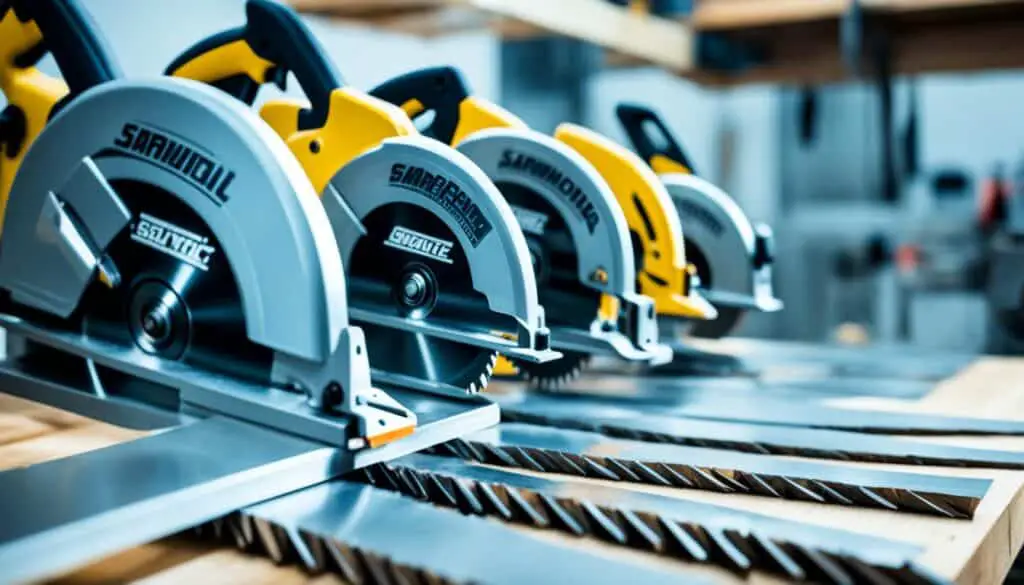
Planes
When it comes to shaping and smoothing wood surfaces, planes are an essential tool in the arsenal of any woodworker. These hand tools consist of a cutting blade known as a plane iron and a body or sole that guides the plane along the wood. With their versatility and precision, planes allow craftsmen to achieve impeccable finishes on their woodworking projects.
There are different types of planes available, each tailored to specific woodworking tasks. Let’s take a closer look at some of the most common types:
- Block planes: Compact and versatile, block planes are perfect for trimming and reshaping small pieces of wood. With their ergonomic design, they offer excellent control and maneuverability, making them a go-to option for various woodworking projects.
- Bench planes: Bench planes are larger in size and are primarily used for flattening and smoothing larger surfaces. They are designed to remove imperfections and achieve a consistently smooth finish, making them indispensable in woodworking.
- Jointer planes: Jointer planes are specifically designed for straightening and smoothing long, flat surfaces. They excel at removing high spots and creating perfectly flat and even surfaces for joinery and furniture-making.
Having a few different planes in your toolkit will allow you to tackle a wide range of woodworking tasks with precision and efficiency.
Benefits of Using Planes:
- Efficiently shape and smooth wood surfaces.
- Achieve precise and flawless finishes.
- Remove imperfections and high spots.
- Create smooth and flat surfaces for joinery.
- Enhance the overall quality and aesthetics of your woodworking projects.
To get a better idea of how planes work and the range of tasks they can accomplish, take a look at the diagram below:
| Diagram of a Plane |
|---|
As you can see, planes are versatile tools that play a vital role in the woodworking process. Whether you’re shaping intricate details or smoothing large surfaces, having the right planes in your collection will elevate your woodworking craft to new levels of precision and excellence.
Sanders
In woodworking, sanders play a crucial role in achieving smooth and flawless finishes on wood surfaces. These essential tools save you time and effort compared to hand sanding, allowing you to focus on other aspects of your woodworking project. With a variety of sanders available, you can choose the one that best suits your needs and preferences.
Types of Sanders
There are several types of sanders commonly used in woodworking:
- Orbital sanders: These versatile sanders are perfect for general sanding tasks. They feature a circular sanding pad that moves in an orbital motion, ensuring a smooth and even finish on your wood surfaces.
- Belt sanders: If you need to remove large amounts of material quickly, a belt sander is the way to go. These powerful tools use a continuous belt to sand away excess wood, making them ideal for shaping and leveling surfaces.
- Random orbit sanders: Combining the best features of orbital and belt sanders, random orbit sanders offer both power and precision. They provide efficient material removal while minimizing swirl marks and creating a smooth finish.
Having a variety of sanders in your workshop ensures that you have the right tool for every sanding task, from general sanding to heavy material removal. Remember to use proper safety precautions when operating sanders, such as wearing protective eyewear and a dust mask to protect yourself from sanding debris.
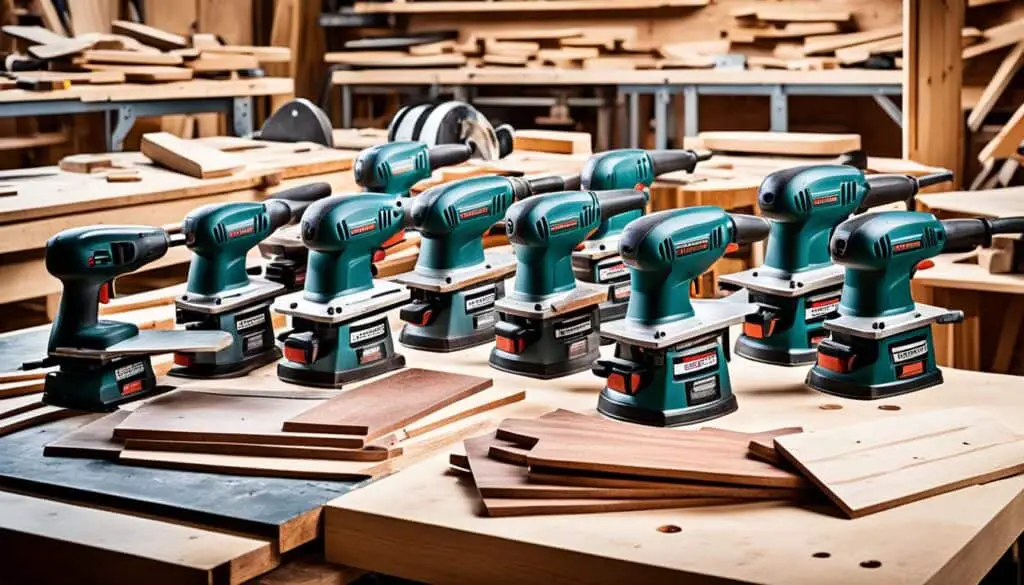
Comparison Table:
| Sander Type | Main Features | Best for |
|---|---|---|
| Orbital Sanders | Moves in an orbital motion Smooth and even finish Versatile | General sanding tasks |
| Belt Sanders | Continuous sanding belt Efficient material removal Shaping and leveling surfaces | Removing large amounts of material quickly |
| Random Orbit Sanders | Combination of orbital and belt sanders Power and precision Minimizes swirl marks | Efficient material removal with a smooth finish |
Files
When it comes to shaping and smoothing wood, files are an essential tool for any woodworking project. These handheld tools feature abrasive surfaces that allow you to remove material and create precise shapes with ease. Whether you’re refining rough edges or sculpting intricate details, having the right set of files in your woodworking hand tools collection is crucial.
There are various types of files available to suit different shaping and smoothing needs. Some common types include:
- Flat Files: Used for general shaping, smoothing, and leveling surfaces, flat files are versatile and allow for efficient material removal.
- Round Files: Ideal for creating concave shapes, round files enable you to shape curves and contours with precision.
- Half-Round Files: Combining the features of flat and round files, half-round files are perfect for tasks that require both flat and curved surfaces.
Investing in a good set of files will significantly enhance your woodworking capabilities. You’ll be able to achieve precise and smooth surfaces on your projects, ensuring a professional finish every time.
Hammer
A hammer is a versatile tool that every woodworker should have in their toolkit. It is essential for driving nails and removing them, making it a staple for various woodworking tasks. When it comes to hammers, there are different types available, each suited for specific purposes.
Claw Hammer: The most common type of hammer used in woodworking, the claw hammer features a flat striking surface on one end and a curved claw on the other. It is perfect for general woodworking tasks, such as driving nails and removing them.
Ball-peen Hammer: Ideal for metalworking tasks, the ball-peen hammer has a rounded striking surface (peen) on one end and a flat surface on the other. While not as commonly used in woodworking, it can come in handy for shaping metal components in woodworking projects.
Dead Blow Hammer: Designed to minimize recoil and provide controlled striking force, the dead blow hammer is an excellent choice for precision work where recoil can affect accuracy. It has a hollow head filled with steel shot or sand, reducing rebound and ensuring efficient and effective strikes.
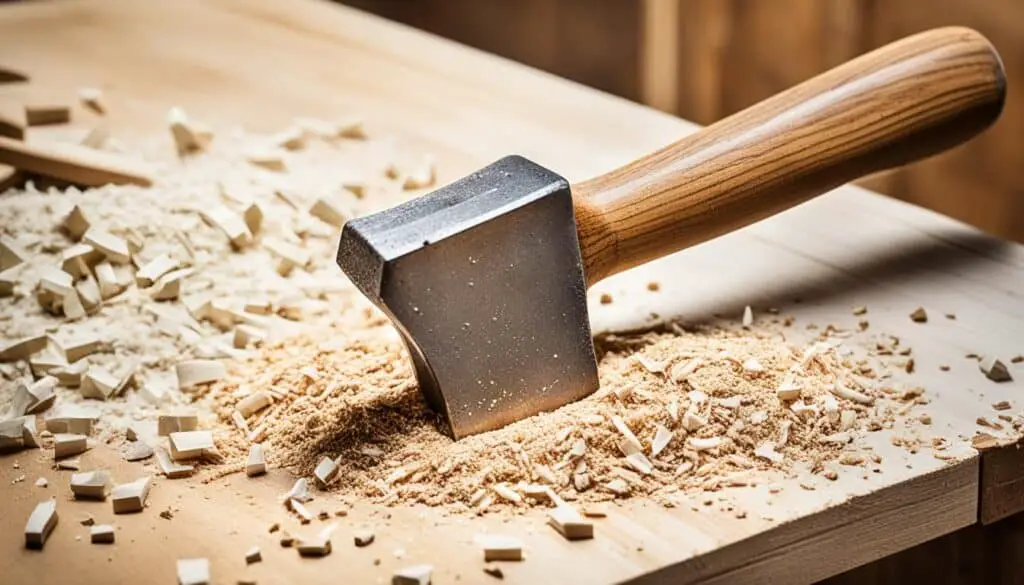
When selecting a hammer, opt for a high-quality one that feels comfortable in your hand and provides a solid grip. A hammer with a sturdy handle and a well-balanced design will help you work efficiently and effectively on your woodworking projects.
Mallet
A mallet is an indispensable tool in the world of woodworking. Specifically designed as a type of hammer, the mallet is used for striking chisels and other woodworking tools with controlled force. Unlike traditional hammers, a mallet minimizes the risk of damaging delicate tools or wood surfaces, making it a preferred choice for craftsmen.
Mallets are typically made from wood or rubber, with wood mallets being the preferred option for woodworking tasks. The wooden construction provides a balanced weight distribution and a comfortable grip, allowing for precise and controlled strikes. The design of a mallet ensures that the force is evenly distributed, reducing the risk of unintended damage to your project.
A mallet’s versatility extends beyond its primary function of striking chisels. It can also be used for various hand tool applications, such as tapping wooden joints together, gently persuading stubborn pieces into place, or aligning workpieces during assembly. With a mallet in your toolkit, you’ll have the means to work with chisels and other hand tools with enhanced precision and control.
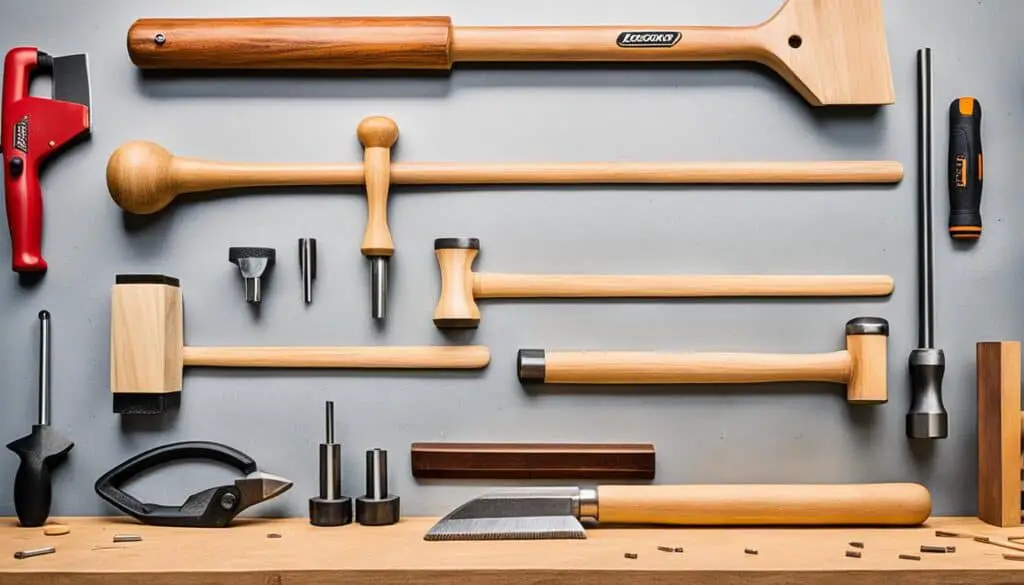
Drill
A drill is an essential tool for woodworking enthusiasts, allowing you to create precise holes in various materials. Whether you’re assembling pieces, installing hardware, or creating joinery, a drill is a versatile and indispensable addition to your workshop. There are different types of drills available, catering to different woodworking needs.
Here are some types of drills commonly used in woodworking:
- Corded Drills: These drills are powered by electricity and provide consistent high power. They are suitable for heavy-duty tasks that require drilling into hard woods or thicker materials. Corded drills are known for their reliability and continuous power supply, making them a popular choice among professionals.
- Cordless Drills: Cordless drills offer greater mobility and flexibility compared to their corded counterparts. They are battery-powered, allowing you to move freely around your workspace without being restricted by cords. Cordless drills provide ample power for most woodworking projects and are especially convenient for jobs that require mobility or drilling in tight spaces.
- Drill Presses: If precision and accuracy are paramount, a drill press is an excellent investment. These stationary tools allow you to make perfectly straight and controlled holes with ease. Drill presses are equipped with adjustable speed settings and depth stops, making them ideal for repetitive drilling tasks and creating consistent results.
Having a reliable drill in your workshop will enable you to tackle a wide range of woodworking projects with confidence and efficiency. Whether you opt for a corded drill, a cordless drill, or a drill press, choose a high-quality tool that suits your specific needs and preferences. Remember to practice proper safety precautions and always wear appropriate protective gear when using a drill.
Screw Gun
A screw gun is an indispensable power tool that is designed specifically for driving screws into wood and various other materials. With its high speed and efficiency, a screw gun surpasses the capabilities of a traditional screwdriver. These power tools are available in both corded and cordless models, offering you the flexibility to choose according to your requirements. Cordless screw guns provide greater portability, allowing you to work freely without being restricted by power cords. Incorporating a screw gun into your toolkit will significantly save you time and effort when assembling and fastening wood pieces.
When using a screw gun, it’s important to select the appropriate screwdriver bit based on the type of screw you are working with. Investing in a good set of screwdriver bits will ensure that you have the right tools for various fastening tasks.
Advantages of using a screw gun:
- Increased speed and efficiency in driving screws
- Greater convenience and portability, especially with cordless models
- Reduced strain on your wrist and hand compared to manual screwdrivers
- Versatility in handling various types of screws
Whether you’re a professional woodworker or a DIY enthusiast, a screw gun is a valuable addition to your collection of woodworking hand tools. Its ability to drive screws quickly and effortlessly will enhance your productivity and overall woodworking experience.
| Pros | Cons |
|---|---|
| Provides fast and efficient screw driving | May not be suitable for delicate or precise work |
| Offers versatility in handling various screw sizes | Requires additional investment compared to manual screwdrivers |
| Reduces strain on the wrist and hand | Needs proper caution to prevent overdriving screws |
| Available in both corded and cordless models | Requires charging or access to power source for cordless models |
| # | Preview | Product | |
|---|---|---|---|
| 1 |

|
SKIL Rechargeable 4V Cordless Screwdriver Includes 9pcs Bit, 1pc Bit Holder, USB Charging Cable -… | Buy on Amazon |
Tape Measure
A tape measure is an essential tool for measuring wood and ensuring accurate cuts and dimensions. It’s a must-have tool for any woodworker. Tape measures come in different lengths, but a 25-foot tape measure is a versatile choice that will cover most woodworking tasks.
Key Features of a Reliable Tape Measure
- Durable construction: Look for a tape measure with a sturdy and durable build to withstand frequent use in a woodworking environment.
- Clear and easy-to-read markings: The tape measure should have clear markings, both in inches and centimeters, for precise measurements.
- Locking mechanism: A reliable tape measure should have a secure locking mechanism to hold measurements in place without any slippage.
- Standout length: Consider a tape measure with a longer standout length, which refers to how far the tape can extend and remain stiff, making it easier to measure long distances on your own.
- Self-marking features: Some tape measures have features like built-in pencil holders or markers, allowing you to make accurate and consistent marks while measuring.
Using a Tape Measure
When using a tape measure, there are a few key tips to keep in mind:
- Always make sure the tape measure is fully extended and aligned with the edge of the workpiece or surface you’re measuring.
- Hold the tape measure firmly in place with one hand, ensuring it doesn’t move or bend as you take measurements.
- Use the locking mechanism to secure the tape measure in place once you’ve obtained the desired measurement.
- Double-check your measurements to ensure accuracy, especially when working on projects where precision is crucial.
Comparison of Popular Tape Measure Brands
| Brand | Length | Features | Price Range |
|---|---|---|---|
| Dewalt | 25 feet | Shock-resistant case, fractional readout, durable blade coating | $20-$30 |
| Stanley | 25 feet | Easy-to-read markings, reliable lock, corrosion-resistant blade | $10-$20 |
| Milwaukee | 30 feet | Nylon bond blade protection, double-sided markings, magnetic hook | $30-$40 |
A reliable tape measure in your toolkit will help you achieve precise measurements every time, ensuring that your woodworking projects are accurate and well-fitted. So, don’t forget to include a quality tape measure in your collection of woodworking hand tools.
Square
A square is an indispensable tool in the world of woodworking. It plays a critical role in ensuring accuracy and maintaining right angles in your woodworking projects. The square is primarily used to mark and measure 90-degree angles, ensuring that your cuts and joints are precise and aligned. With a square, you can achieve the perfect corners and edges that enhance your woodworking craftsmanship.
There are different types of squares available, including combination squares and try squares. Combination squares are versatile and can be used for a variety of measuring tasks beyond checking right angles. They often feature built-in levels and protractors, making them invaluable for other project requirements.
Try squares, on the other hand, are specifically designed for checking the squareness of edges and corners. They have a simple yet effective design that allows you to quickly verify the accuracy of your work.
Having a square in your woodworking toolkit is essential, regardless of your skill level. It ensures that your measurements are precise and your angles are true, which is crucial for creating high-quality woodworking projects.
With a square, you can confidently proceed with your woodworking projects, knowing that your angles and measurements are accurate. Whether you’re building furniture, cabinets, or other intricate woodwork, a square is an indispensable tool that will help you achieve professional-level results.
Conclusion
Woodworking is a rewarding craft that allows you to unleash your creativity and create beautiful and functional pieces. To embark on this journey, it is crucial to have the right tools in your workshop. Throughout this guide, we have explored the essential woodworking tools that every craftsman should have.
From hand saws and power saws to planes, sanders, and measurement tools, these tools serve as the foundation for your woodworking projects. By investing in high-quality woodworking tools, you ensure accuracy, precision, and durability, enabling you to bring your ideas to life with confidence.
Whether you are just starting or have years of woodworking experience, having the right woodworking tools is paramount. Each tool plays a crucial role in shaping and transforming raw materials into masterpieces. With the right tools by your side, you can elevate your woodworking craft and take your projects to new heights.
So, armed with your woodworking tool set, unleash your imagination and enjoy the immense satisfaction of creating something beautiful with your own hands. Remember, woodworking is not just a hobby; it is a lifelong passion that allows you to leave a lasting legacy through your craftsmanship.
FAQ
What are the essential woodworking tools for craftsmen?
The essential woodworking tools for craftsmen include hand saws, power saws, planes, sanders, files, hammer, mallet, drill, screw gun, tape measure, and square.
What are hand saws used for?
Hand saws are used for cutting materials and shaping wood. There are different types of hand saws available, each designed for specific cutting tasks such as crosscut saws, rip saws, and coping saws.
How are power saws beneficial in woodworking?
Power saws make cutting through wood easier and faster. Circular saws, jigsaws, and compound miter saws are a few types of power saws that are versatile and suitable for various cutting tasks.
What are planes used for in woodworking?
Planes are essential tools for shaping and smoothing wood surfaces. They come in different types such as block planes, bench planes, and jointer planes, each serving a specific purpose in woodworking tasks.
What are sanders used for in woodworking?
Sanders are used for sanding and smoothing wood surfaces. Orbital sanders, belt sanders, and random orbit sanders are popular types of sanders that offer versatility and efficiency in achieving smooth finishes.
How are files used in woodworking?
Files are hand tools used for shaping and smoothing wood. Different types of files, such as flat files, round files, and half-round files, are available for various shaping and smoothing tasks.
What is the purpose of a hammer in woodworking?
A hammer is used for driving and removing nails in woodworking. Claw hammers, ball-peen hammers, and dead blow hammers are examples of hammers used for different woodworking tasks.
How is a mallet different from a hammer in woodworking?
A mallet is a type of hammer used specifically for striking chisels and other woodworking tools without damaging them or the wood surface. Wood or rubber mallets are commonly used in woodworking tasks.
What is the role of a drill in woodworking?
A drill is used for making holes in wood and other materials, as well as for assembling pieces, installing hardware, and creating joinery. Corded drills, cordless drills, and drill presses are some types of drills used in woodworking.
Why is a screw gun important in woodworking?
A screw gun is a power tool designed specifically for driving screws into wood and other materials. It offers speed and efficiency compared to using a traditional screwdriver, making it a time-saving tool for assembling and fastening wood pieces.
What is the purpose of a tape measure in woodworking?
A tape measure is essential for measuring wood accurately, ensuring precise cuts and dimensions. It is a must-have tool for any woodworker to achieve accurate results in their woodworking projects.
How is a square used in woodworking?
A square is used for checking right angles and ensuring accuracy in woodworking projects. Combination squares and try squares are common types of squares used for measuring and checking the squareness of edges and corners.
What are the most important woodworking tools for craftsmen?
The most important woodworking tools for craftsmen include hand saws, power saws, planes, sanders, files, hammer, mallet, drill, screw gun, tape measure, and square. These tools enable craftsmen to create beautiful and functional woodworking projects.


